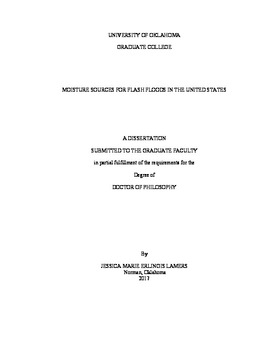| dc.description.abstract | This dissertation uses backward trajectories derived from North American Regional Reanalysis data for 19,253 flash flood reports published by the National Weather Service to assess the nonlocal contribution of the land surface to the moisture budget for flash flood events in the conterminous United States. The impact of land surface interactions was evaluated seasonally and for six regions of interest: the West Coast, Arizona, the Front Range, Flash Flood Alley, the Missouri Valley, and the Appalachians. Parcels were released from flooded locations and traced backward in time for 120 hours. The boundary layer height was used to determine whether moisture increases occurred within the boundary layer or not. For moisture increases occurring within the boundary layer, moisture increases were attributed to evapotranspiration from the land surface. Surface properties were recorded from an offline run of the Noah land surface model.
In general, moisture increases attributed to the land surface were associated with anomalously high surface latent heat fluxes and anomalously low sensible heat fluxes (resulting in a positive anomaly of evaporative fraction) as well as positive anomalies in top layer soil moisture. Over the ocean, uptakes were associated with positive anomalies in sea surface temperatures, the magnitude of which varies both regionally and seasonally. Major surface-based source regions of moisture for flash floods in the United States include the Gulf of Mexico, Gulf of California, and central United States, which are attributable in part to interactions between the land surface and the atmosphere.
While much of this dissertation focuses on the large-scale sources for moisture for flash flood events, storm-scale phenomena are also investigated for a precipitation event during the Integrated Precipitation and Hydrology Experiment. A case of stratiform precipitation impinging on complex terrain was examined for its microphysical properties that could result in enhanced rainfall. The data from a field experiment show coalescence processes dominate within the upslope region, suggesting enhanced updrafts aided by orographic lift sustain convection over the upslope region, leading to larger median drop diameters. | en_US |
